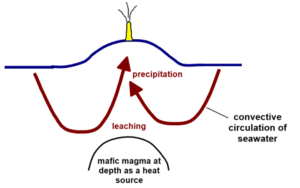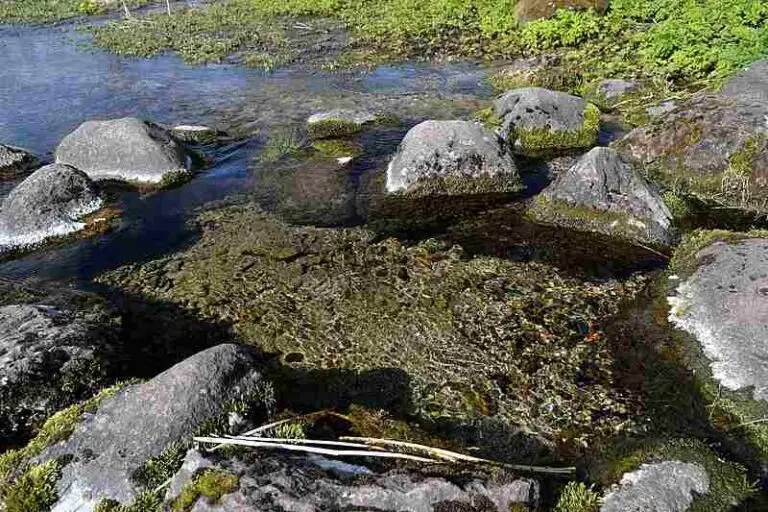3 Geothermal Energy Examples Explained
Geothermal energy examples are; solid-state conduction, hydrothermal convection, and dimorphic retention. This article discusses the examples of geothermal energy mechanisms, as follows;
1). Geothermal Heating by Solid-State Conduction (as one of the Geothermal Energy Examples)
Geothermal energy can be observed as it is transmitted by conduction through rocks in their solid state.
This means that it is not top uncommon to extract geothermal energy from solid rocks.
Geothermal energy from rocks is renewable because its primary source is nuclear heat produced by radioactive decay of isotopes like potassium and thorium in the subsurface [2].
The occurrence of geothermal energy as a product of conduction through solid rocks is particularly favored by the presence of rocks with high thermal conductivity, melting point, and spatial connections to other conductive rocks.
In areas where these subsurface rocks have been subjected to significant shear stress, geothermal energy can be naturally released to the surface through the fractured rocks in the form of hot spring waters.
The natural occurrence of stored geothermal energy by solid-state conduction has helped in the development of energy extraction techniques that involve the installation of heat exchangers at depth, which conduct geothermal heat to the surface [4].
Also, the energy efficiency of geothermal processes in any given zone can be evaluated by measuring the thermal conductivity of subsurface solid rocks [3].
2). Geothermal Heating by Hydrothermal Convection
Geothermal energy can occur in the form of convected heat, in subsurface hydrothermal fluids.
Hydrothermal fluids are particularly common and effective as carriers of geothermal energy, due to their high mobility and conductivity.
Geothermal energy convection is the cyclic transmission of heat in the subsurface as hot and cool conductive fluid masses ascend and descend respectively.
As a result, the assessment of locations for their viability as geothermal power plant-sites is often based on the presence and abundance of hydrothermal resources [5].
However, total dependence on hydrothermal convection as a transmission mechanism by which geothermal energy can be extracted also comes with the risk of resource depletion, since hydrothermal fluids can decrease in volume.
This implies that solid-state conduction is arguably a more sustainable mechanism, form, or example of geothermal energy, with no resource depletion risk.

3). Geothermal Heating by Dimorphic Retention (as one of the Geothermal Energy Examples)
Dimorphic retention is a less-common example of geothermal energy dynamics in subsurface zones.
It occurs in cases where geothermal heat is transmitted through rocks that contain significant proportion of minerals that can occur in more than one states that are in equilibrium with each other, like quartz-rich granite and diorite [6].
Dimorphic retention is often caused by solid-state conduction of extremely-large amounts of geothermal heat that leads to partial melting of the solid rock conductor.
The specific conditions of dimorphic retention in any given case depends on geographic and thermal conductivity factors [1].
Conclusion
Geothermal energy examples are;
1. Solid-State Conduction
2. Hydrothermal Convection
3. Dimorphic Retention
References
1). Angilletta, M. J. (2001). "Thermal and Physiological Constraints on Energy Assimilation in a Widespread Lizard (Sceloporus undulatus)." Ecology 82(11):3044. Available at: https://doi.org/10.2307/2679833. (Accessed 26 January 2023).
2). Clauser, C. (2011). "Radiogenic Heat Production of Rocks." Available at: https://doi.org/10.1007/978-90-481-8702-7_74. (Accessed 26 January 2023).
3). Di Sipio, E.; Chiesa, S.; Destro, E.; Galgaro, A.; Giaretta, A.; Gianluca, G.; Manzella, A. (2013). "Rock Thermal Conductivity as Key Parameter for Geothermal Numerical Models." Energy Procedia 40(2):9219-. Available at: https://doi.org/10.1016/j.egypro.2013.08.011. (Accessed 26 January 2023).
4). Jia, G.; Tao, Z. Y.; Meng, X.; Ma, C. F.; Chai, J. C.; Jin, L. W. (2019). "Review of effective thermal conductivity models of rock-soil for geothermal energy applications." Geothermics 77:1-11. Available at: https://doi.org/10.1016/j.geothermics.2018.08.001. (Accessed 26 January 2023).
5). Liao, Z. (2018). "Hydrothermal Convection Systems and Geothermal Energy in the Southwest China." Thermal Springs and Geothermal Energy in the Qinghai-Tibetan Plateau and the Surroundings (pp.211-262). Available at: https://doi.org/10.1007/978-981-10-3485-5_8. (Accessed 26 January 2023).
6). Zheng, H.; Luo, J.; Zhang, Y.; Feng, J.; Zeng, Y.; Wang, M. (2021). "Geological Characteristics and Distribution of Granite Geothermal Reservoir in Southeast Coastal Areas in China." Frontiers in Earth Science 9:683696. Available at: https://doi.org/10.3389/feart.2021.683696. (Accessed 26 January 2023).





